
Top Instructional Design Models for Creating Effective Corporate Training

Related articles
Get valuable eLearning insights to your inbox.
Listen to Neovation’s Demystifying eLearning podcast generated with NotebookLM!
Listen to our podcast on your favorite platform!
Effective corporate training is more than just content delivery; it requires a structured approach to ensure real impact. Many organizations struggle to create training that is both efficient and engaging and achieves clear business objectives. This is where instructional design models provide their most significant value.
Grounded in decades of research in cognitive psychology and learning science, instructional design models serve as the essential blueprints for creating strategic, efficient, and impactful learning experiences.
These frameworks provide a systematic process for analyzing learner needs, designing effective instruction, and evaluating success. By following a structured model, L&D teams can move beyond guesswork and ensure that every aspect of their training—from initial goals to final assessments—is purposeful and aligned.
This article will explore key instructional design models, their applications, and how they facilitate effective corporate training development.
What Are Instructional Design Models?
Instructional design models are systematic frameworks that provide a structured process for creating effective learning experiences. They serve as a blueprint for any training program, guiding designers through a series of steps from analyzing learner needs and defining clear objectives to developing content and evaluating its success.
Rooted in cognitive psychology and systems engineering, early models emphasized core principles, such as clear learning objectives and immediate feedback. Over the decades, these frameworks have evolved significantly, shifting from linear processes to more interactive and iterative approaches that now incorporate digital tools, online learning, and advanced concepts like AI and gamification.
Why Instructional Design Models Are Crucial for Training Excellence
Instructional design models ensure every phase of the development process is efficient, purposeful, and grounded in proven learning science. They provide systematic workflows, creating training that is not only engaging but also consistently delivers on its objectives:
- ID models provide a clear, step-by-step process that keeps complex projects organized, focused, and on track.
- ID models facilitate collaboration among designers, subject matter experts, and stakeholders, enabling projects to adapt to evolving needs and constraints.
- Projects are developed in phases for evaluation and iteration, enabling the early identification of potential flaws and the continuous refinement of materials to ensure a high-quality final product.
- ID models help create experiences that boost knowledge acquisition and retention, which ultimately drives business success and a clear return on investment.
Instructional design models provide a structure that empowers organizations to create well-structured, focused, and easily understandable courses, leading to better learning outcomes and a tangible return on investment.
Exploring Key Instructional Design Models for Corporate Training
Instructional design models guide designers through a series of steps to ensure that learning experiences are not only engaging and efficient but also strategically aligned with organizational goals. While many models exist, a few have become particularly influential in shaping modern corporate training.
Here is an exploration of some of the most popular models of instructional design, including their core characteristics and common applications in a corporate setting:
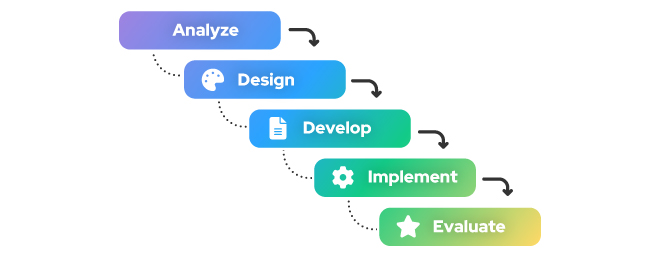
ADDIE Model
The ADDIE model of instructional design is one of the most well-known and foundational frameworks in the field. The acronym ADDIE stands for its five distinct phases: Analysis, Design, Development, Implementation, and Evaluation.
Its emphasis on thorough front-end analysis can lead to lower development costs and a highly structured, well-planned final product.
What ADDIE is best used for
The ADDIE model is effective for larger and more complex training programs that benefit from a clear, systematic approach.
ADDIE provides a reliable and comprehensive structure that ensures all aspects of training development are methodically addressed.
Key feature
While originally linear, modern applications of ADDIE incorporate iterative cycles and continuous feedback, allowing for flexibility.
How it’s used
ADDIE is an excellent starting point for organizations new to formal instructional design due to its straightforward process, such as when developing a customer service training program for new staff with varying skill levels.
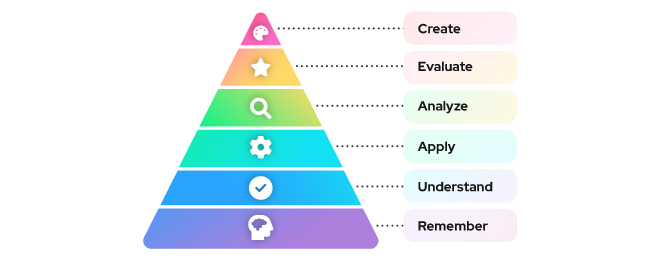
Bloom’s Taxonomy
Bloom’s Taxonomy is a critical tool for shaping the cognitive, affective, and psychomotor depth of any training program. This framework can help instructional designers determine which domain (cognitive, affective, or psychomotor) best aligns with the overall learning goal.
Developed by Benjamin Bloom, this hierarchical framework categorizes cognitive skills into six levels of increasing complexity: Remember, Understand, Apply, Analyze, Evaluate, and Create.
What Bloom’s Taxonomy is best used for
Bloom's Taxonomy is used to write clear and measurable learning objectives, ensuring that assessments and learning activities align with the cognitive skills.
For instance, when designing a spreadsheet course, a designer might use it to create activities that require learners to not only remember formulas but also to apply and analyze data to solve real-world problems.
Key feature
Bloom’s Taxonomy serves as a powerful tool for designing curricula that deliberately promote higher-order thinking and move beyond simple knowledge recall.
How it’s used
This framework is essential for creating instruction that is both intellectually challenging and purposefully aligned with specific learning outcomes.
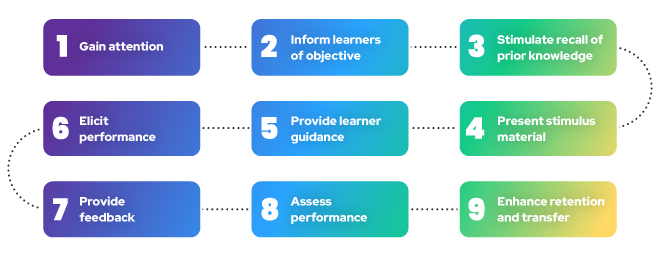
Gagné’s Nine Events of Instruction
Proposed by Robert Gagné, this influential framework provides a clear roadmap for structuring individual lessons or training modules.
This framework describes nine key instructional "events" that are crucial to the learning process and are best addressed in sequence to maximize learning effectiveness. These events range from gaining the learner's attention at the start to providing feedback and enhancing the long-term retention and transfer of knowledge at the end.
What Gagne’s Nine Events is best used for
This model is used to structure and sequence training sessions, ensuring that all components necessary for effective learning are included.
It serves as a checklist for designers to create lessons that capture attention, inform learners of objectives, stimulate recall of prior knowledge, and offer ample opportunities for practice and feedback.
Key feature
Gagne’s Nine Events of Instruction is only recommended when addressing classroom learning with a formal, in-person teaching context.
How it’s used
By following Gagne’s nine events, instructional designers can create a complete and highly effective learning sequence from start to finish.
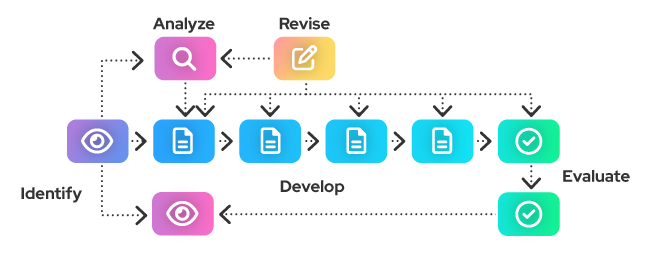
Dick and Carey Model
This model, developed by Walter Dick and Lou Carey, offers a comprehensive and systematic approach by viewing instruction as a complete system. It presents instruction as a system of interrelated components, including the instructor, learners, materials, and learning environment.
What Dick and Carey is best used for
This model is an excellent choice for complex projects where the interplay between all components of the learning environment is key to success.
A healthcare organization, for example, might use it to systematically design a training program for nurses on safe medication administration, ensuring that every step, from needs analysis to evaluation, is tightly aligned.
Key feature
The model emphasizes the careful alignment of goals, analysis, strategy, and evaluation through a nine-step process to create effective and cohesive educational experiences.
How it’s used
The Dick and Carey model is well-suited for performance-oriented training programs where measurable goals and systematic processes are critical.
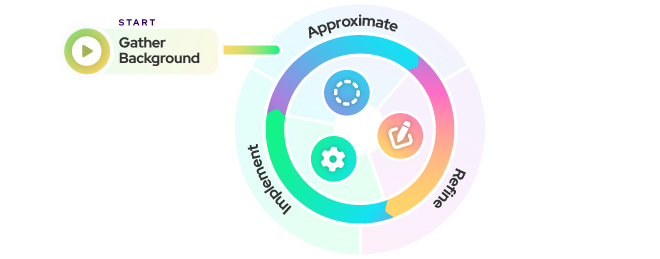
SAM (Successive Approximation Model)
Developed as a more agile alternative to traditional linear models, SAM prioritizes speed, collaboration, and iteration. The SAM model of instructional design is an iterative and recursive process that emphasizes rapid development cycles and continuous collaboration with stakeholders.
What Dick and Carey is best used for
SAM is particularly useful for projects with complex subject matter, evolving technologies, or tight deadlines.
It is widely applied in the tech space, where a software company might use SAM to quickly prototype and test training for a new platform, continuously incorporating user feedback throughout the development process.
Key feature
Rather than a linear path, it focuses on creating and testing prototypes early and often through phases of Preparation, Iterative Design, and Iterative Development.
How it’s used
This model's strength lies in its ability to adapt quickly, making it ideal for fast-paced and collaborative projects.

Kirkpatrick Evaluation Model
The Kirkpatrick Model is the industry standard for evaluating the effectiveness and business impact of training programs. This model is an evaluation model rather than an instructional design model, but can be used interchangeably with other models of instructional design.
Developed by Dr. Donald Kirkpatrick, this framework assesses the impact of training at four distinct levels:
- Reaction (did they like it?)
- Learning (did they learn it?)
- Behavior (are they using it?)
- Results (did it impact the business?)
What Kirkpatrick is best used for
This model is used when organizations need to understand a training program’s true value and identify areas for improvement.
It helps move beyond simple satisfaction surveys to gauge how training influences on-the-job behavior and contributes to overall business results.
Key feature
This model provides a clear path to demonstrating the tangible return on investment (ROI) of a training initiative.
How it’s used
Instructional designers use this model to systematically evaluate training by assessing its impact across four levels (mentioned above).
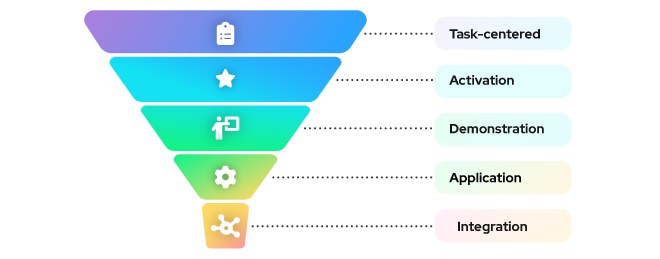
Merrill’s Principles of Instruction
This model, developed by M. David Merrill, comprises a set of core principles centered on creating problem-based and highly practical learning.
MPI is a task-centered approach that emphasizes showing learners what they will learn, rather than simply telling them.
What Principles of Instruction are best used for
MPI is ideal for creating instruction that is highly engaging, relevant, and practical.
It is used when the goal is to facilitate deep learning through authentic, real-world tasks and the active application of knowledge in contexts that are meaningful to the learner.
Key feature
This model is built on five principles. Learning is promoted:
- When it is task-centered
- When prior knowledge is activated
- When new knowledge is demonstrated
- When knowledge is applied
- When it is integrated into the learner’s world.
How it’s used
This framework is invaluable for ensuring training is directly tied to on-the-job performance and skill application.
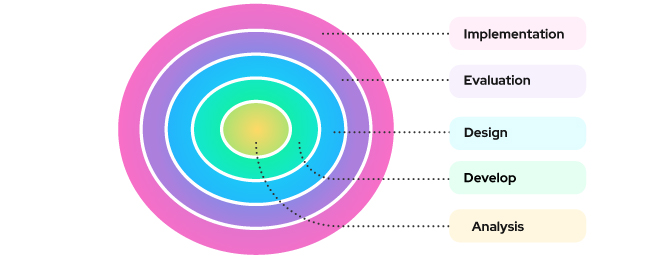
Kemp Design Model
The Kemp Design Model is distinguished by its flexible, non-linear approach to the instructional design process. The Kemp instructional design model features a circular structure that emphasizes adaptability and a continuous cycle of planning, design, and evaluation across nine key elements.
What Kemp Design Model is best used for
This model's flexible, holistic approach makes it suitable for a wide range of learning projects, including both digital and face-to-face training.
It is particularly effective for larger projects with multiple moving parts or various stakeholders, where its nonlinear nature can accommodate evolving requirements.
Key feature
With this model, an instructional designer can start at any point in the process, making it highly adaptable to project needs.
How it’s used
Its strength lies in providing a comprehensive yet adaptable framework suitable for complex and dynamic training initiatives.
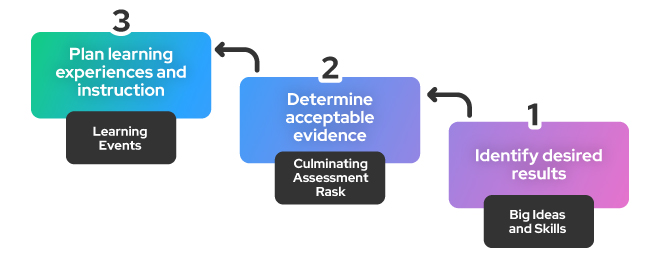
Backward Design
Also known as Understanding by Design (UbD), this model’s core philosophy is to begin with the end goal in mind. The Backward Design approach starts by identifying the desired learning outcomes and then works backward to create assessments that measure those outcomes. It then plans learning experiences and instruction that will lead to success.
What Backward Design is best used for
This model is beneficial when the primary goal is to maintain a sharp focus on the big-picture learning objectives and ensure a strong alignment between goals, assessments, and activities.
It is an intuitive approach that ensures all instructional activities are purposeful and directly contribute to the desired outcomes.
Key feature
Backward Design is a sequential and goal-oriented process that begins with identifying the desired final learning outcomes before planning any instructional activities.
How it’s used
This model ensures that instruction is laser-focused on what learners truly need to know and be able to do.
How Neovation’s Custom Learning Team Uses Instructional Design Models for Client Success
Neovation’s Custom Learning team leverages instructional design models to create training that meets your unique challenges and drives measurable results. Our approach to client projects is founded on a systematic analysis, learner-centric design, and iterative development—the better we understand your unique training needs, the better we can select the best instructional design model for your project.
Here’s how we apply these principles to ensure your project's success:
- Strategic needs assessment: We begin projects with a thorough analysis of your training materials and goals to understand your learner needs and specific training objectives, ensuring every element of the course is purposeful and aligned for maximum impact.
- Instructional design application: Our team applies proven learning theories to transform your content into clear, engaging, and memorable experiences. We leverage interactive elements, storytelling, and realistic simulations to enhance knowledge retention and facilitate the practical application of skills.
We combine the systematic rigor of established models of instructional design with the flexibility of a project partner. We don't just build courses; our instructional design team provides a comprehensive, end-to-end service that manages every detail, guarantees quality, and ensures your custom training solution effectively meets your needs and delivers a clear return on investment.
Instructional Design Models FAQs
What is the difference between an instructional design model and an instructional strategy?
An instructional design model is the overall framework or blueprint used to systematically design and develop learning experiences. Models like ADDIE provide a high-level structure with broad phases (e.g., Analyze, Design, Develop).
In contrast, an instructional strategy consists of the specific techniques and methods used within that model to help learners achieve their objectives. For example, "Develop Instructional Strategy" is a single component of the Dick and Carey model that includes choices about content presentation, learner participation, and assessment methods based on learning theories like behaviorism or constructivism.
Which instructional design model should I select for my project?
Instead of rigidly selecting a formal model, the focus should be on a collaborative process to find the best solution. The selection should be guided by factors such as:
- Your specific training goals and desired learning outcomes.
- The readiness and complexity of your source material.
- The overall scope and duration of the project.
A flexible approach involves assessing your current materials, developing a design demo, and creating resources based on an approved design and storyboard, rather than strictly adhering to one named model.
Can you use more than one instructional design model in a single project?
Many models are described as variations of the ADDIE model, implying that designers often blend or adapt elements to fit a project's needs. The iterative nature of models like Dick and Carey and the principles of rapid prototyping also support a flexible process.
This suggests that designers are more likely to incorporate best practices and elements from different models and theories rather than rigidly adhering to a single one.
What factors should guide my choice of an instructional design model?
Your choice of an instructional design model or approach should be guided by the following key factors:
- Project Scope and Goals: The specific training objectives and the overall size of the project.
- Desired Learning Outcomes: The model must support the achievement of clear, measurable goals.
- Learner Engagement: The need to create interactive and immersive experiences that captivate learners.
- Content and Complexity: The readiness of your source material and the desired complexity of the final product.
- Brand and Visual Identity: The ability to customize the design to reflect your organization’s unique brand.
- Cost and Efficiency: The potential to reduce training costs and create reusable learning assets.
- Accessibility: The requirement that all materials are fully accessible to everyone.
- Team Integration: The ability to blend expert support with your in-house L&D team’s workflows.
From Blueprint to Business Impact: The Power of Expert Instructional Design
Instructional design models serve as the blueprints for developing corporate training that is effective, engaging, and delivers measurable results. They provide a proven, systematic framework that moves beyond simply presenting information, ensuring instead that every learning experience is purposefully built to achieve specific goals and drive real behavioral change.
At Custom Learning, we employ instructional design models to meet your organization's unique culture, challenges, and objectives. We help you transform your training initiatives from a necessary cost into a powerful strategic asset that enhances employee performance, boosts retention, and drives long-term organizational success.

Alex is an experienced writer and marketer with an interest in all things education. With a background in literary theory, technical writing, and document design, he is interested in how learners make meaning from language and how to create meaningful connections through writing.
Become part of our L&D community
We publish a new learning hub article — full of useful, practical topics — weekly.
Not sure where where you want to start? Jump into one of our recently published articles and see where it takes you!






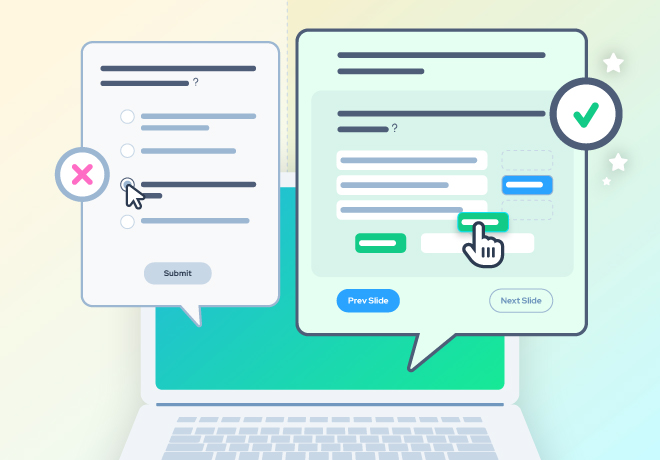
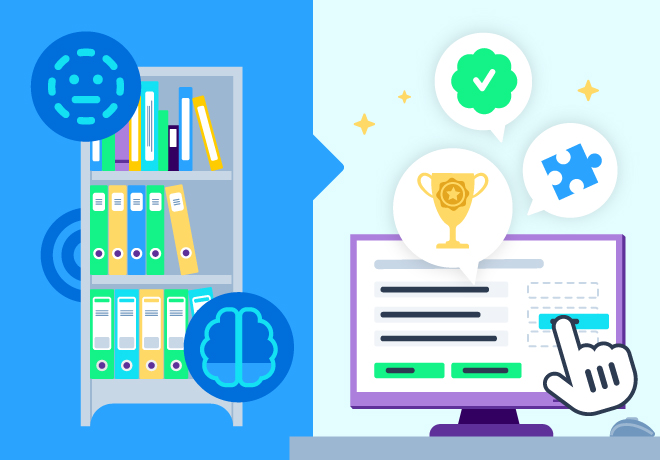
-svg.svg)
-svg.svg)
-svg.svg)
-svg.svg)